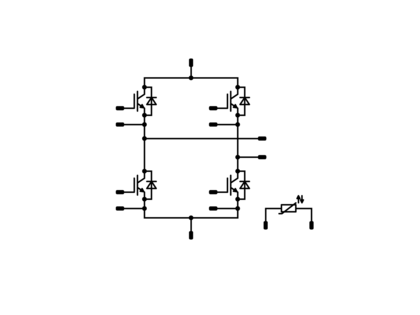
Structure
An H-bridge module is equipped with four IGBTs and four free-wheeling diodes, which usually have 600 V, 1200 V or 1700 V blocking voltage. The IGBTs and diodes often share the same current rating. MOSFETs with 600 V are also frequently used in H-bridges as SiC components are used more and more. Nearly all modules are equipped with an NTC or PTC alongside the power semiconductors.
Application
H-bridge modules are often used in solar inverters, UPS systems, welding equipment and power supplies.
How it works
In single-phase photovoltaic inverters and single-phase UPS applications, H-bridges serve to convert AC into DC voltage.
The load voltage's polarity alternates periodically, so the full DC-link voltage can be used, rather just half as is the case with a single half-bridge. This is why most single-phase applications operate with a DC-link voltage of around 400 V.
H-bridges are also used in welding devices and in other power supplies. In these applications, they drive a transformer that usually reduces the DC-link voltage to a lower potential.
This is generally done at high switching frequencies ranging up to and beyond 100 kHz to enable the use of small inductors.
To learn more and see the full range of products, follow this link: H-bridge

